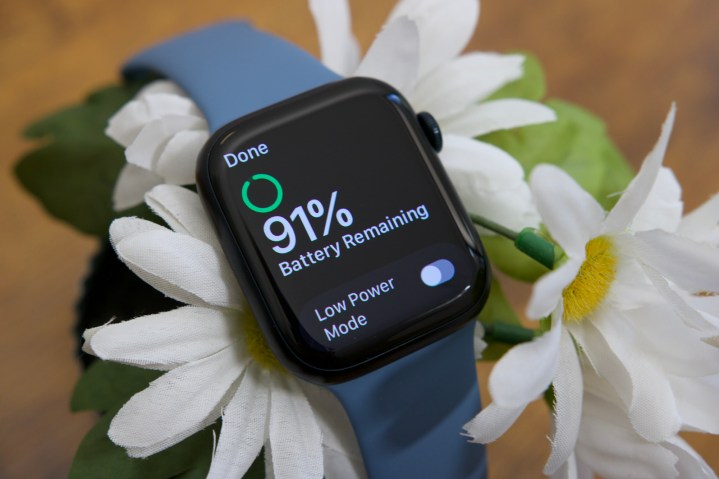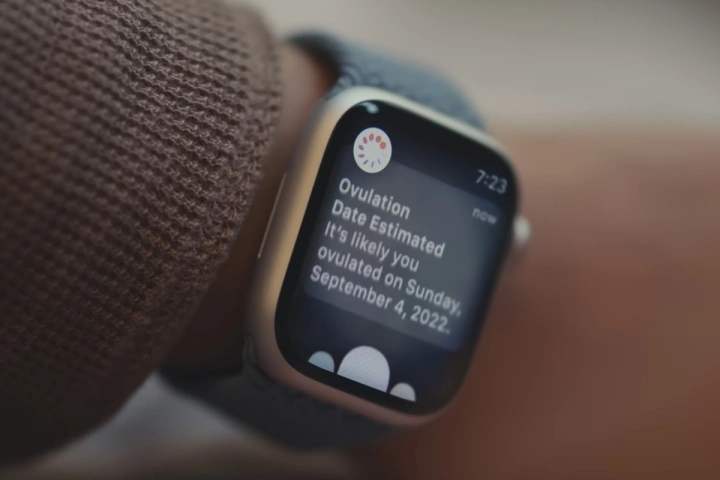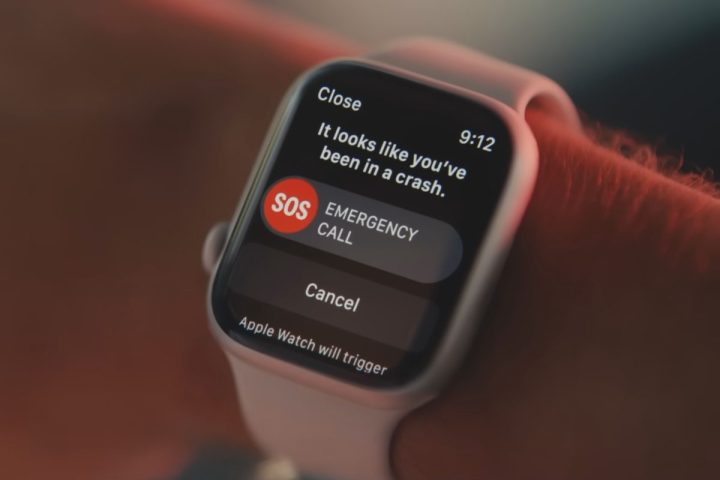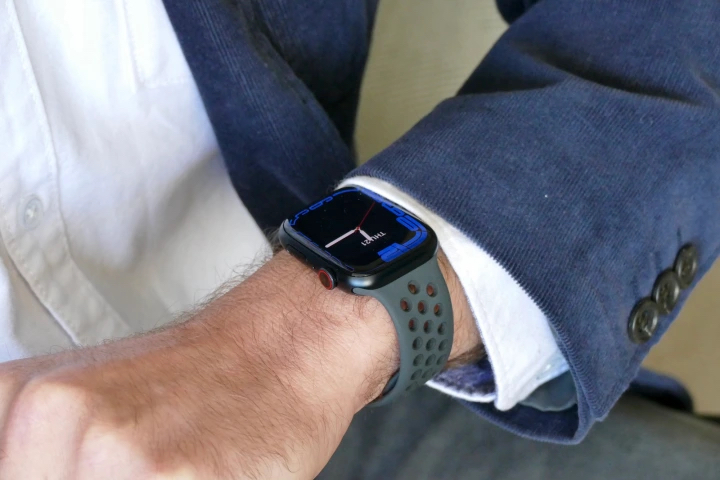This year’s Apple Watch Series 8 and last year’s Apple Watch Series 7 are strikingly similar, both offering a vast array of fitness and functionality that far exceed any competing smartwatch brand currently available. The biggest distinctions between the Watch 7 and Watch 8 are some high-end health and safety features that Apple has added to the newest model.
Instead of piling a load of specialty features and updates onto its general audience of iPhone users, Apple opted to break out and target high-end sports enthusiasts with a brand new Apple Watch Ultra that’s engineered especially for the adventurous crowd. For the rest of us perhaps trying to decide if or when to replace an older civilian model, Apple has made the decision much easier with the mid-tier Apple Watch 8. We compare and contrast the new Apple Watch Series 8 and the Apple Watch Series 7 to detail what has changed and what has stayed the same.
Specs
| Apple Watch Series 8 |
Apple Watch Series 7 | |
| Display size | 41mm: 1.53 inches
45mm: 1.78 inches |
41mm: 1.53 inches
45mm: 1.78 inches |
| Body size | 41mm
45mm |
41mm
45mm |
| Resolution in pixels | 41mm: 352 x 430
45mm: 396 x 484 |
41mm: 352 x 430
45mm: 396 x 484 |
| Touchscreen | 41mm: LTPO OLED Retina
Always-on display45mm: LTPO OLED Retina Always-on display |
41mm: LTPO OLED Retina
Always-on display45mm: LTPO OLED Retina Always-on display |
| Storage | 32GB | 32GB |
| Wireless interface | Bluetooth 5.0, Wi-Fi 802.11 b/g/n, NFC, LTE | Bluetooth 5.0, Wi-Fi 802.11 b/g/n, NFC, LTE |
| Depth | 0.41 inches / 10.5mm | 0.41 inches / 10.5mm |
| Blood oxygen sensor |
Yes | Yes |
| Accelerometer | Yes | Yes |
| Gyroscope | Yes | Yes |
| Ambient light sensor | Yes | Yes |
| Heart rate sensor | Yes | Yes |
| Barometer | Yes | Yes |
| GPS | Yes | Yes |
| Compass | Yes | Yes |
| Water/dust resistant | IP6X | IP6X |
| Battery life | Up to 18 hours (36 hours in Low Power mode) | Up to 18 hours (36 hours in Low Power mode with WatchOS 9) |
| Price | From $399 | From $399 |
| Availability | Apple | Apple |
| DT review | 4.5 out of 5 stars | 5 out of 5 stars |
Design and display

At first glance, it’s hard to tell the difference between the 2021 Apple Watch Series 7 and the new Apple Watch Series 8. They both sport the same signature square Apple Watch design, dimensions, and weight and are available in the same 41mm and 45mm case sizes. There are a few subtle differences in colors and finishes. The Apple Watch Series 8 comes in aluminum and stainless steel only, while the Series 7 offered a titanium option, which now appears to be reserved exclusively for the hard-core, adventure-centric Apple Watch Ultra. Both versions have the same color choices for the stainless steel models — silver, gold, Graphite, and Space Black — though Series 7 has more color options on the aluminum models, including blue, green, red, Starlight, and Midnight. Series 8 eliminated the green and blue hues but added silver while keeping the red, Starlight, and Midnight colors.
The 41mm Apple Watch Series 8 features an always-on LTPO Retina OLED display with a resolution of 352 x 430 pixels, while the 45mm model resolution is 396 x 484 pixels — identical to the previous models. The aluminum model’s screen is covered by the Ion-X front glass, while the premium stainless steel model gets the tougher sapphire crystal covering. The screen can reach a peak brightness of 1,000 nits, while the storage capacity is 32GB, both the same as the Apple Watch Series 7. New watch faces for Series 8 include Lunar, Astronomy, Modular, and Metropolitan.
There’s no immediate visible difference between the two Apple Watch models. This is a draw.
Winner: Tie
Performance, battery life, and charging

The Apple Watch Series 8 features a new dual-core S8 system-in-chip that Apple says is 20% faster than the S7 chip of the previous generation. Connectivity for the new series includes LTE, Wi-fi 802.11 b/g/n, and Bluetooth 5.0 for wireless pairing with other devices — the same as its predecessor. The new watch’s battery should last some 18 hours on a single charge, identical to the previous watch series. Our testing supports that claim and then some. After a full day’s use, we found the battery life ended in the 30% to 40% remaining range. That economical battery usage was consistent even through fitness workouts, a day’s worth of notifications, and timer usage, alongside the always-on screen.
If that doesn’t go far enough, the Apple Watch Series 8’s new Low Power mode lets your watch operate for up to 36 hours on a single charge. This is twice the rated 18-hour battery life. It can do that because Low Power mode disables some services and features like the always-on Retina display, workout autostart, and heart health notifications while maintaining most operations in normal mode. Both watches support magnetic wireless charging, with a full charge complete within an hour.
Winner: Apple Watch Series 8
Fitness and health-tracking features

Apple announced two new temperature sensors for the Apple Watch 8 — a new skin temperature sensor that’s designed to detect a 0.1 degree Celsius temperature change in your body and a sensor underneath the screen to measure temperature fluctuations during sleep. The Watch 8 takes your wrist temperature during sleep every five seconds, which Apple says can help you recognize illnesses early and assist with ovulation tracking. It can also fine-tune menstrual predictions by alerting wearers to unexpected cycle deviations. Irregular menstrual cycles can indicate health issues, and that’s where the temperature-sensing data can be of service to women and families. As our reviewer noted, the stats will show up in the Health app, but with no clue as to what they mean or what to do about them, if anything.
Other sensors with the Series 8 watch include a blood oxygen sensor to measure SpO2 levels, an electric heart sensor for measuring electrocardiogram (ECG), a third-generation optical heart rate sensor for pulse tracking, an ambient light sensor, an updated high-G accelerometer, and a gyroscope. These sensors are not new but are fine-tuned, updated versions of features already present in the Apple Watch Series 7.
Winner: Apple Watch Series 8
Software and updates

The Apple Watch Series 8 ships with the latest operating system — WatchOS 9 — already installed, and the new OS is currently available for older Apple Watch models. The updated operating system carries most of the weight, and WatchOS 9 is available to Series 4 and later watch models. Some of the newer features will be restricted to connected iPhones running iOS 16 or later. The Series 8 is an upgrade over the Series 7, so expect to get more done more quickly on the new model, but the speed will likely not be obvious to most casual users.
The new WatchOS debuts four new watch faces, several Workout app updates, improved sleep tracking, atrial fibrillation (AFib) history, and a new Medications app. The Compass app, when used with the new Backtrack feature, comes in quite handy in helping the direction-challenged find their way back to a hike starting point and even lets you record landmarks you can check off along the way. Anyone who’s ever been lost on a hike as it’s getting dark knows how valuable this can be.
Winner: Apple Watch Series 8
Special features

The Apple Watch Series 8, like the Series 7, has an Always-On display, fall detection, and all the watch faces you know and love. A big distinction between Apple Watch 8 and its predecessors is two new and improved sensors that advance safety and peace of mind for families. A three-axis gyroscope and a G-Force accelerometer that records 3,000 samples per second can detect when you are in a vehicle crash. Crash detection uses sensors and features like the barometer, GPS, and microphone on your new iPhone 14 and iPhone 14 Pro to determine the intensity of the accident. We did not test this feature firsthand, but others did and confirmed that in a fairly realistic testing environment involving actual collisions, the feature worked as advertised with the iPhone 14. When it does detect a severe crash, the Apple Watch 8 automatically calls 911 for help, provides your location, and notifies your emergency contacts if you don’t respond to an on-screen notification within 10 seconds.
Both watch versions offer a water resistance rating of up to 50 meters and IP6X dust resistance, but the crash detection really pushes the Series 8 to the win here.
Winner: Apple Watch Series 8
Price and availability

The Apple Watch Series 8 is available in the U.S. and over 40 countries. The base model with GPS connectivity and 41mm case size costs $399, while models with cellular connectivity start at $499. The 45mm model starts at $429, while its cellular sibling costs $529.
For Apple Watch Series 8 buyers, Apple is bundling a free three-month subscription to Apple Fitness+ — a discount from the standalone purchase price of $10 per month or $80 per year. Best Buy is also throwing in four months of free Apple Fitness+, Apple News+, and Apple Music subscriptions as a bonus on select models for U.S. buyers.
Apple is no longer selling the Series 7 directly, but it’s still available at a discount at Amazon and Walmart.
Winner: Apple Watch Series 8
Overall winner: Apple Watch Series 8
The Apple Watch Series 8 is a worthy successor to the Apple Watch Series 7 because its upgrades are substantial and non-cosmetic. Nonetheless, the Apple Watch Series 8 is a minor upgrade over the Series 7, with the body temperature sensors and Crash Detection feature the only significant changes. For Apple Watch Series 7 owners, the Series 8 is objectively a superior wrist computer, but unless you genuinely need the specific new features introduced in Series 8, consider yourself lucky to already possess such a useful and beautiful device in which most major specs remain the same.



